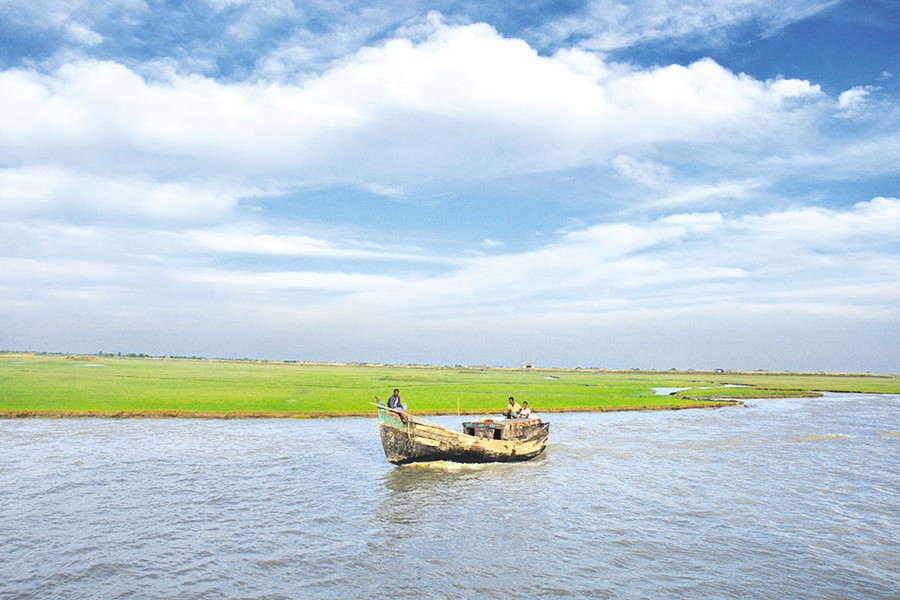Those who are mulling a visit to the famous coastal island of Nijhum Dwip, the Island of Silence, ought to think deeply before they set out for the tour in the country's south. The first reason, they might feel completely disillusioned over the fact that all they have heard about the islet do no longer apply to the tourist spot. Maybe, those were once true; that, too, a couple of decades ago. Today they emerge before many of the aspiring tourists as mere myths. There is an ambience of tranquility, but no chirping of birds or the views of vast expanses of grassland. Clusters of trees are there, but they are not dense enough to aptly deserve the sobriquet of a 'lush green forest'. Human habitats are few, and most of them are peopled by rootless folks from the far-off areas. Evidently, they are mostly the victims of river erosion. New settlers are growing. Different types of people live here to raise cattle, mostly buffaloes. Grazing buffaloes are a normal site here. Some people on the island have erected sheds for goats. The once idyllic islet is located near the Hatiya upazila, also a big island. It takes two-and-half hours by trawlers to reach Nijhum Dwip from Monpura's Fish Terminal under the Bhola district, the largest island in Bangladesh.
There are also poultry farms, the birds of which could be seen moving around the shabbily built huts on Nijhum Dwip. People settled on the islets also eke out their living by felling trees which is prohibited. But the fish-drying and selling the dried fish as 'shutki' is allowed. Except these mostly dispersed human settlements, there are a few government offices on Nijhum Dwip. Most of the offices belong to the forest department.
Thus, people especially the youths visiting the island aboard unsafe trawlers struggling with waves of the Padma and the Meghna hitting the boats might lose their heroism before they reach their destination. Since its location is on the very estuary of the two mighty rivers, where the waters do give the look of a sea, many youths have the tendency to feel themselves as Robinson Crusoe. The islet could have been turned into a veritable Crusoesque land. And it could have drawn hordes of adventure-loving young men (and women) round the year. Unfortunately, the authorities have frittered their opportunities away. They could have utilised their creativity and spent resources there to build modern resorts amid the façade of the wild. The very barren look of the island today has enough elements to make one feel sad. Immediately after the `discovery' of the island, the forest department and the local administration could have jointly embarked on a grand project centring the 'dwip'. Location-wise everything could have gone in their favour. There was the seclusion, with few threats coming from encroachers. The early stage of a forest with similarity to the Sundarbans had been there. What was needed was the missionary zeal to turn the land, encircled by waters, into an artificially created inaccessible land. Instead, after the initial news splashed in the media on the find, the island's future was made to follow a different course. In the couple of decades, trees began thinning out; many young trees faced untimely death.
What could have emerged as an ideal spot of artificial or make-do primitiveness found itself being in dire straits. In ten to fifteen tears after Nijhum Dwip's spectacular emergence on the country's map, illegal hunters living in the larger islands nearby haven't wasted time before swooping down on the newborn island's deer population. It's worth mentioning that the early news about the emergence of this Crusoesque island remained especially focused on the place's rich deer population.
The news carried enormous value. It's because the news of the appearance of a new patch of green-covered land in the middle of coastal waters didn't elate a large number of people. But what had created elation was the islet's rich deer population. It's an unsavoury truth that most the enthusiastic travellers to Nijhum Dwip once included both amateur and professional deer hunters. Thanks to their indiscriminate deer-hunting, the number of the deer population has dwindled to a few hundred from a mind-boggling number. Nowadays, lots of highly intrepid and curious trawler-bound travellers brave the awe-inspiring expanses of the Padma and the Meghna to land on the islet. As feared, their frantic search for wild deer on Nijhum Dwip results in pure disenchantment. Disappointed, most of them return to their respective master ships, even in early winter, with sun burns and a bad taste in the mouth.
The entire cruise to the island could be changed radically. However, the onus lies with both the private and government tour operators. As the tourists at present have to embark on their tours toNijhum Dwip on roofless and rickety engine boats spending two-and-half hours in mid river, the operators can press into service small motor-launches on this route. Thanks to the comfort and the feel of safety, the passengers, especially the elderly, would not object to spending a tolerably hefty sum of money as fare for the trips. Standard motor-launches and smaller ships can accomplish the job. But the shallow depth of water in the channel at the entry often impedes the service. The shallowness of the island channel cannot be corrected. But the trips to the island could be made safer and comfortable.
Although the Nijhum Dwip visitors are yet to be allowed officially to spend night on the island, they can derive enormous joy and leisure and peace from the island's beach --- before sunset though.


